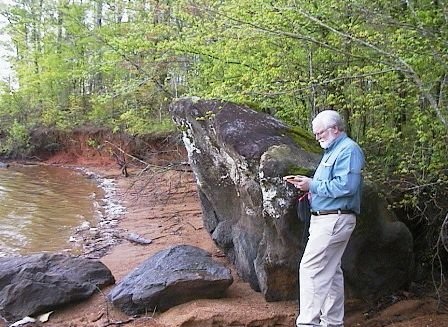| Ernie Seckinger | |||
| Biography # 209 | email: ernie.seckinger@zebra.net | ||
OK, a try at a one page bio. The email address is ernie.seckinger@zebra.net The occupation is archeologist. Born in 1950. Pen interest: Definitely vintage. Vac, snorkel, Esterbrook J’s and Transitionals, would love to get into early 20th century Waterman and general flexible nibs. Everyday user. I have not bid on items that went for low prices since the original stickers remained and I (as an archeologist) would find it hard to remove the sticker. I need to use the pen! Vintage ink but the debate about Quink and Vacumatic diaphragms has me nervous. Not a mechanical person. I can change Esterbrook nibs and sacs, clean a pen, smooth a nib (with some errors). About 50 pens and 40 inks, but about 6 or so everyday users: black Balance II, retired blue Vanishing Point, a black and a blue Waterman Phileas, a 51, an Esterbrook Transitional (with my own custom nib that flows like a river with Omas blue ink). A few 1920s mechanical pencils. Everyday inks Aurora black, Omas blue, old Sheaffer black–when good paper available, Sheaffer red and Rotring red for editing. Waterman Florida blue, Sheaffer black, and Namiki blue cartridges for travel (of which there is far too much). I began the use of a fountain pen around 1965, probably in the 10th grade. That Sheaffer translucent blue cartridge pen is still with me and began my reentry into the fountain pen world in 1998. I suppose its smoothness is due to the thousands of miles its steel nib has written. It is a lot of fun with PR Naples Blue. Around 1970 I came into a copper Esterbrook J, inherited from a great great uncle. Its nib was beyond horrible though and saw little use until I encountered a fellow Baldwin County, Alabama resident known as the Polish Sumgai. From him I not only got a new nib, but also began a minor collection of various Esterbrooks. If by the way you think they are no fun, what pen do you think Tippi Hedren uses in The Birds? Perhaps the pen I am most proud of is a Parker 75 Cisele that I bought for my mother, Christmas 1972, when I was the pen department manager of Millers Book and Office Supply on Broad Street in Atlanta, a store now sadly defunct. She recently returned the favor and presented the pen to me. Once I began again, there was no turning back. A trip to Phoenix found me at Flax where I bought a nice pen cabinet that now covers the part of my desk not occupied by my computer monitor, bottles of ink, or pen desk sets. I have made an effort to slow down acquisition though and have begun the process of cull to improve my collection. I also try to spend more time writing with them. My writing has four forms: journal, letters, creative, and reading notes. The journal uses the most ink. I write a fair number of letters but in the day of telephone and email, when I do get an answer it most often comes through those latter media. To receive a handwritten letter or note is a joy. My creative writing begins its first draft with a pen. The final moves, when adequate, to my website: www.zebra.net/~ernie.seckinger where I deal with matters of reading and Transcendentalism as well as the obligatory section on genealogy. For the archeology connection, a fountain pen will not write on Rite-in-the-Rain® paper! Since my training was in the prehistoric tradition, I know little about the archeology of writing and pens, but now find the topic fascinating. Unfortunately, most ink bottles greater than 75 years old are dug from privies by those who, meaning to or not, destroy archeological deposits and data. So, I do not collect those. Each morning, I stumble to the table for breakfast and the day’s more substantial reading. I use there a pen and a particular ink until used up or my mood changes. Abbreviated–hopeful refined–versions of these notes become reading notes on my website. Daphne is in the Mobile metro area. It is a true struggle each day to drive to work across the head of Mobile Bay (or the lower end of the Mobile River Delta depending on which way you look) seeing along the way pelicans–both brown and white in the fall and winter, ibis, gulls by the gezillion, the Battleship Alabama, through the 1941 Bankhead Tunnel (named for Tallulah’s father) on to park in a downtown Mobile historic district within 100 feet of a live oak tree.
|
|||
